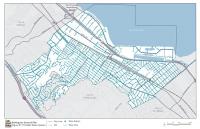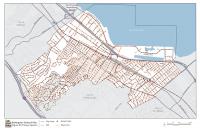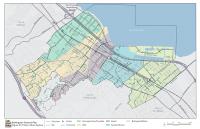Stormwater Drainage and Flood Control
Most of Burlingame’s storm drainage infrastructure was constructed in the early twentieth century. The City has constructed and maintains a network of open ditches and subsurface drainage pipes that supplement the natural streams, carrying urban runoff and stormwater flows into San Francisco Bay. The drainage infrastructure also includes pump stations in low-lying areas to move water toward the Bay. To address the age and condition of drainage and flood control infrastructure, in 2008 the City prepared a Storm Drain Improvements Report to highlight high-priority projects and guide upgrade investments within five watersheds: Easton, Burlingame/Ralston, Sanchez/Terrace, Mills and El Portal/Trousdale. Annual storm drain fees assessed to all properties fund the $39 million in bonds sold to finance identified improvements through 2039 (see Figure IF-3). The improvement program is specifically designed to help increase storm drainage capacity, replace aging pipes and pumps, improve public safety, and reduce local flooding.
According to the Federal Emergency Management Agency (FEMA), the agency responsible for preparing Flood Insurance Rate Maps (FIRMs), Burlingame is located primarily within Zone X 0.2, which means there is a 0.2 percent annual chance of flood hazard (referred to as a 500-year storm event), and partially within Zone X - Area of Minimal Flood Hazard. Properties along certain creeks and on the Bayside of Highway 101 lie within Zone A, Zone AE, Zone AH, and Zone VE, all of which have mandatory flood insurance requirements. Figure IF-4 shows the flood zones in Burlingame.
Due to the age of the regional system, many of the storm drain systems have a 10-year design storm capacity, not the standard 30-year capacity for regional facilities. Some local storm drain systems also have less than a two-year design storm capacity, where the standard is also 10 years. In addition to these flood concerns, the City will be subject to flooding over time due to sea level rise, as outlined in the Safety Element. Flood protection improvements represent critical infrastructure investments needed to protect life and property and encourage continued private economic investment throughout Burlingame.
Goal: IF-4
Protect people and property from the adverse effects of flooding through a stormwater system that adequately moves runoff from existing and future development, prevents property damage due to flooding, and improves environmental quality.
Plan for and implement low impact development (LID) retrofits, such as green infrastructure which uses vegetation and soil to capture, treat, and retain stormwater runoff. Promote the use of pervious surfaces, green streets, and rainwater harvesting to achieve multiple benefits, such as creating open space, improving stormwater quality, and increasing groundwater recharge. Avoid or minimize the impact of stormwater discharges on local receiving waters, including San Francisco Bay.
Design smart improvements to public spaces—including streets, parks, and plazas for stormwater retention and groundwater infiltration—by diverting urban runoff to bioretention systems and implementing LID techniques. Integrate green infrastructure that restores a natural hydrologic system such as trees, rain gardens, and vegetated swales into the urban environment. Encourage stormwater facilities that are designed to be a functional and attractive element of public spaces.



